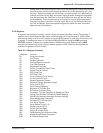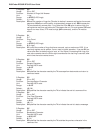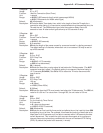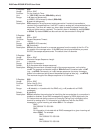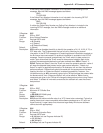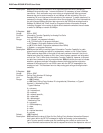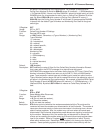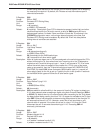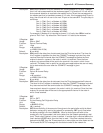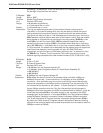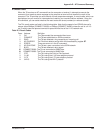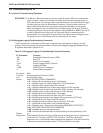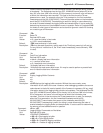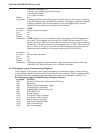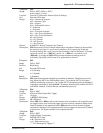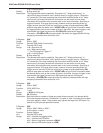
Appendix D - AT Command Summary
RF300E/RF310E 147
Description: S83 controls whether or not the modems will handle possible V.110 calls. If S83=0,
then it will not be assumed that the modems support V.110 and the V.110 call will fail.
Auto-protocol detection is required to be enabled on the TA port that corresponds to
the modem port that is intended to answer V.110 calls. If the corresponding TA port is
busy, then the call will roll over to the next TA port on the same BRI. The port setup is
as follows:
Port 1—TA#1 Port 1 or Modem #1, BRI#1
Port 2—TA#1 Port 2 or Modem #2, BRI#1
Port 3—TA#2 Port 1 or Modem #3, BRI#2
Port 4—TA#2 Port 2 or Modem #4, BRI#2
Port 5—TA#3 Port 1 or Modem #5, BRI#3
Port 6—TA#3 Port 2 or Modem #6, BRI#3
For example, if Modem #1 is intended to answer V.110 calls, then S83=1 must be
given to TA#1 Port 1. By default the TA will send V.110 calls to the modems.
S-Register: S84
Usage: S84=n; S84?
Function: Data to Terminal Delay
Unit: 10ms
Range: n=0 (no delay),
n=1-255 (10ms-2.55s)
Default: 0 (no delay)
Description: S84 controls the delay time for data sent from the TA to the terminal. The timer for
this S-register is started at the time the CONNECT message is printed. Any data
received from the B-channel after the CONNECT message but before the timer
expires is stored in a queue in the order in which it is received. Once the timer
expires, any queued data will be sent to the terminal in the order in which it was
received. This delay timer is useful for use with some applications that are not ready
for to receive data too soon after the CONNECT message is given.
S-Register: S85
Usage: S85=n; S85?
Function: Data to B-channel Delay
Unit: 10ms
Range: n=0 (no delay),
n=1-255 (10ms-2.55s)
Default: 0 (no delay)
Description: S85 controls the delay time for data sent from the TA to the appropriate B-channel.
The timer for this S-register is started at the time the CONNECT message is printed.
Any data received from the terminal after the CONNECT message but before the
timer expires is stored in a queue in the order in which it is received. Once the timer
expires, all queued data will be sent to the appropriate B-channel in the order in
which it was received.
S-Register: S87
Usage: S87=n; S87?
Function: En-bloc Analog Call Origination Delay
Unit: 100ms
Range: n=0-255 (0-25.5s)
Default: 10 (1 second)
Description: S87 allows flexibility of the amount of time given to the period after a digit is dialed
before an analog call is sent to the network for processing. S87 is only used when
the dialing method is En-bloc (%A97=0). When a device goes off-hook on the
analog port, the TA generates a dial tone (rather than the network generating a dial
tone). Once a digit is dialed, a timer is started. If another digit is received before the
timer reaches the S87 value, then the timer is reset. If the timer reaches the value
determined by S87, then the TA assumes that no more digits are to be dialed and the
TA will send the SETUP message with the dialed number to the network for



